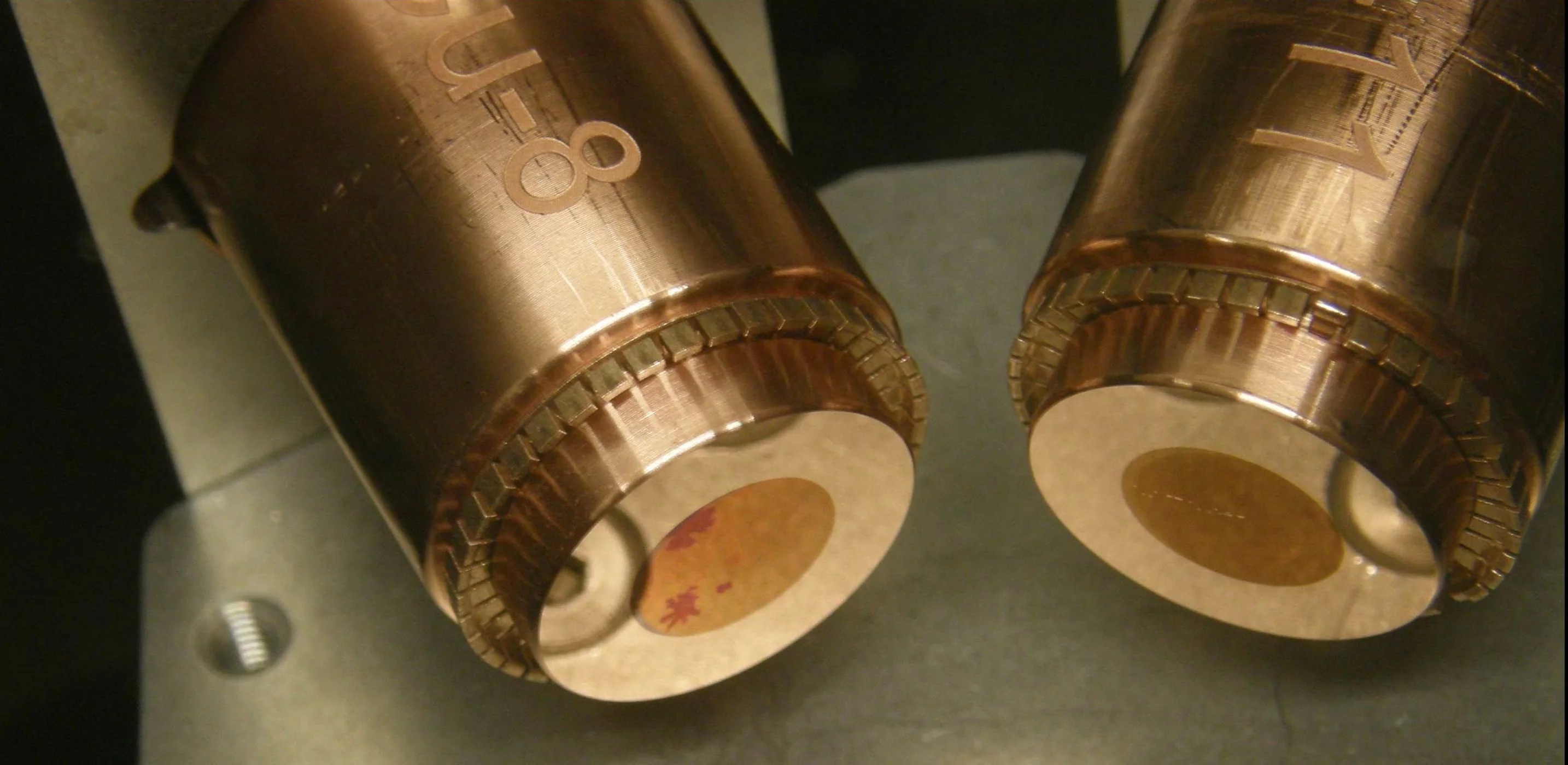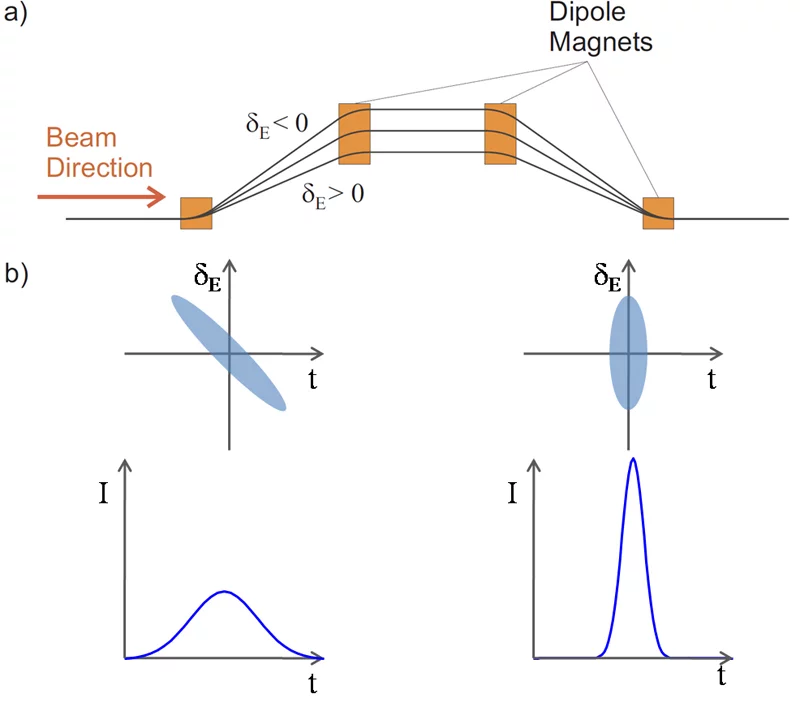SwissFEL Accelerator Design
The SwissFEL design (see image below) is based on an electron accelerator, consisting of a high-brightness electron gun, a booster, three sections of linear accelerator (linac) and two bunch compressors (BC).
Electrons are extracted at energies from 2.1 to 5.8 GeV and fed to two undulators, long arrays of alternately-poled permanent magnets, where intense, coherent X-ray pulses are generated for two X-ray beamlines, "Athos" and "Aramis", operating in parallel.
Important specifications of the SwissFEL are summarized in the table below.
Important specifications of the SwissFEL are summarized in the table below.
| Main parameters | |
|---|---|
| Wave length | 1A -50Å |
| Photon energy | 0.25-12 keV |
| Pulse duration | 1fs - 20fs |
| e Energy | 5.8 GeV |
| e Bunch charge | 10 - 200 pC |
| Repetition rate | 100 Hz |
The Injector
RF Gun
The baseline technology for the SwissFEL electron injector relies on the radio frequency (RF) gun photo injector concept. A photo cathode placed in a highfield RF cavity is illuminated with a short laser pulse. The timing of the laser pulse is synchronized to the RF, so that electrons are emitted when the accelerating RF field on the cathode reaches an optimum value. For the past two decades, RF gun technology has been the subject of intense R&D activities at various leading accelerator laboratories worldwide, and remarkable progress has been achieved. The present state-of-the-art allows the production of electron pulses of 200 pC charge, with normalized emittances below 0.4 micrometer. This is sufficient to operate the SwissFEL at nominal wavelength and beam energy. However, to reach these parameters, the pulses produced from the gun have to be much longer (typically several ps) than the final pulse of a few femtoseconds as required in the FEL. Therefore, the pulse has to be longitudinally compressed in the linear accelerator, downstream of the injector.
The Accelerator
The SwissFEL linear accelerator (linac) must fulfill two functions:
- acceleration of the electron pulse from the injector to the nominal energy of the FEL
- time compression of the electron pulse from 5 ps r.m.s. to 25 fs r.m.s
The demands for compactness and economy suggest the use of a normal-conducting, pulsed RF system for acceleration, with rather high accelerating fields. A key design parameter for such a linac is the total RF energy supplied per pulse by the RF transmitters to the accelerating cavities.
This parameter strongly influences the investment cost and electric power consumption of the overall facility and can be minimized either by reducing the local accelerating field or by increasing the RF frequency. Since reducing the field increases the overall facility length, an increase of the RF frequency is the more promising approach.
However, such an increase goes together with a decrease in the size of the accelerator components, thus leading to even tighter mechanical and electrical tolerances. While most normal-conducting electron linear accelerators nowadays operate at an RF frequency of 3 GHz, the SwissFEL uses a 5.7 GHz C-band RF system, and will be the first large-scale linac of this type in Europe. For temporal pulse compression, two magnetic chicanes are placed in the linac at 320 MeV and 2.1 GeV. The electron pulse is accelerated in the linac slightly off the crest of the RF wave. This introduces a time/energy chirp along the electron pulse. The energy dependence of the electron path length in magnetic chicanes then leads to a time compression. Two 12 GHz RF structures are used to linearize the curvature of the time/energy chirp before the electron pulses enter the first magnetic chicane.
This parameter strongly influences the investment cost and electric power consumption of the overall facility and can be minimized either by reducing the local accelerating field or by increasing the RF frequency. Since reducing the field increases the overall facility length, an increase of the RF frequency is the more promising approach.
However, such an increase goes together with a decrease in the size of the accelerator components, thus leading to even tighter mechanical and electrical tolerances. While most normal-conducting electron linear accelerators nowadays operate at an RF frequency of 3 GHz, the SwissFEL uses a 5.7 GHz C-band RF system, and will be the first large-scale linac of this type in Europe. For temporal pulse compression, two magnetic chicanes are placed in the linac at 320 MeV and 2.1 GeV. The electron pulse is accelerated in the linac slightly off the crest of the RF wave. This introduces a time/energy chirp along the electron pulse. The energy dependence of the electron path length in magnetic chicanes then leads to a time compression. Two 12 GHz RF structures are used to linearize the curvature of the time/energy chirp before the electron pulses enter the first magnetic chicane.
The FELs
Two SASE FEL lines are driven by the linac: a hard X-ray FEL named "Aramis" and a soft X-ray line named "Athos".
| SwissFEL | Aramis beamline | Athos beamline |
|---|---|---|
| Undulator period | 15 mm | 38 mm |
| Undulator parameter | 1.2 | 1.0-3.5 |
| Undulator module length | 4.0 m | 2.0 m |
| Undulator section length | 4.75 | 2.8m |
| Average ß-function | 15 m | 10 m |
Aramis, with the undulator parameters given in the table above, covers the wavelength range 1–7 Å, and Athos the wavelength range 6.5–50 Å. For Aramis, a planar undulator with a novel type of permanent magnet (dysprosium-enriched NdFeB) is planned. The magnet array is mounted inside of the vacuum tank. To reach the required parameters, the inter-magnet gap which is available for the beam is as small as 4.5 mm. The use of dysprosium-enriched NdFeB magnets allows these undulators to be operated at room temperature, thus avoiding a costly liquid nitrogen cooling system, as is normally required for undulators with comparable parameters. A total of 12 undulators of this type, each 4 m long, have to be aligned in a row within tight tolerances to ensure that the Aramis FEL can reach the SASE saturation regime.
For the Athos FEL, the undulator period length is more relaxed, and the permanent magnet arrays can therefore be situated outside of the vacuum chamber. These undulators are built in the so-called APPLE configuration, which allows for a full control of the FEL polarization and wavelength by adjusting the mechanical position of the magnet arrays with high precision. Movements of the magnet arrays with submicron accuracy have to be performed in the presence of very strong magnetic forces, making the mechanical design of the mover systems particularly challenging. The feature of polarization control will be particularly advantageous for magnetization dynamics experiments.
Furthermore, it is foreseen that the Athos undulator modules will be only 2 m long with short magnetic chicanes between each segment. This will allow for new modes of operation with higher peak brightness in comparison to standard SASE lasing. The chicane in-between the undulators can be used to delay the electron bunch to ensure that the lasing slice always gets supplied with fresh electrons. Such schemes allow for the spectral width of the FEL radiation to be narrowed and for an increased longitudinal coherence. The Athos undulator line will be designed to also allow for a conventional SASE operation.
Parameters and schematic layout key parameters of the SwissFEL are summarized in the table below:
For the Athos FEL, the undulator period length is more relaxed, and the permanent magnet arrays can therefore be situated outside of the vacuum chamber. These undulators are built in the so-called APPLE configuration, which allows for a full control of the FEL polarization and wavelength by adjusting the mechanical position of the magnet arrays with high precision. Movements of the magnet arrays with submicron accuracy have to be performed in the presence of very strong magnetic forces, making the mechanical design of the mover systems particularly challenging. The feature of polarization control will be particularly advantageous for magnetization dynamics experiments.
Furthermore, it is foreseen that the Athos undulator modules will be only 2 m long with short magnetic chicanes between each segment. This will allow for new modes of operation with higher peak brightness in comparison to standard SASE lasing. The chicane in-between the undulators can be used to delay the electron bunch to ensure that the lasing slice always gets supplied with fresh electrons. Such schemes allow for the spectral width of the FEL radiation to be narrowed and for an increased longitudinal coherence. The Athos undulator line will be designed to also allow for a conventional SASE operation.
Parameters and schematic layout key parameters of the SwissFEL are summarized in the table below:
Parameters and schematic layout
| Key parameters of the SwissFEL | |
|---|---|
| Overall length (incl. experimental hall) | 740 m |
| Total electric power consumption | 3.8 MW |
| Electron beam energy | 5.8 GeV |
| Technology of linear accelerator | Normal-conducting copper cavities at 6 GHz |
| Charge per electron pulse | 0.2 nC |
| Normalized beam emittance | 0.4 mm∙mrad |
| Number of X-ray pulses per second | 200 (100 at each photon beamline) |
| X-ray pulse duration | 24 fs |
| X-ray brilliance | 1.3∙1033 photons/∙(s∙0.1%∙b.w.∙mm2∙mrad2) |
| Shortest lasing wavelength | 0.1 nm |



